In Plain Light 05.17 – The Norway Issue
Welcome to this month's newsletter!
In this issue:
You may want to rotate your phone in order to improve your browsing experience on this site.
Looking for unique wall art?
If you like pictures on this page, be sure to visit the online shop and browse prints of Norway and Svalbard landscapes available there.
Ask for a quote on your favourites, made to order with exact dimensions and your choice of frame!
May 17 is Constitution Day, the national day in Norway. The date recalls the events of 1814, when the country was forced out of one personal union (with Denmark) into another (with Sweden).
It isn't a significant anniversary, but I will spend a week before it in Norway, and then another three in July and August. This will make my total number of visits to the country exceed that of any other place in the world.
Something tells me, it should be worth explaining.
Useless knowledge: Happy nation
Norway ranks very highly in international comparison. Currently, it leads world's best lists in, among others,
- Human Development Index
- Democracy Index
- World Happiness Report
Isn't it a reason enough to visit the modern Vikings in their home?
Where in the world...
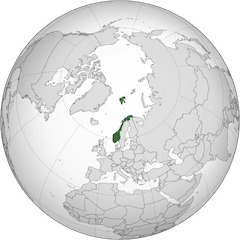 Norway on the globe
Norway on the globeIf you squint your eyes when looking at the Scandinavian Peninsula, you can pretend it being a big dog lying on its paws. The latter and the belly would form Sweden, while the head, the back, and the tail will become Norway.
The country's mainland stretches over 13° of latitude, from 58° to above 71°N, and covers the longitude from 5°E to 31°E. Its easternmost point in Vardø lies farther east than Istanbul.
You could also say, Norway is Europe's forehead facing the North Atlantic and the Arctic Oceans.
The west coast between Stavanger in the south and North Cape extends over 1,600 km (just under 1,000 mi) as the crow flies, however, many fjords reaching deep inland form a coastline of 25,148 km (15,630 mi) in length. With its numerous islands, Norway sports the shores of 83,281 km (51,759 mi), more than twice the length of the equator.
A journey along this coast is one of the most fascinating experiences you can make aboard a ship. How would you like going on the "world's most beautiful sea voyage"?
A long story
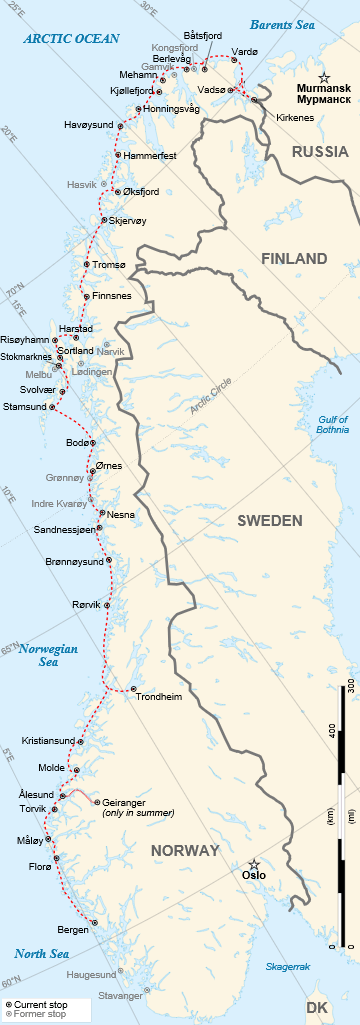 Hurtigruten itinerary
Hurtigruten itinerarySVG template by Sardon, Carlos-X
This attribute has been in use for Hurtigruten, "the fast route", the famous ferry line along the Norwegian coast with daily departures.
The regular service started in 1893 between Trondheim and Hammerfest. The ships carried post, freight, and passengers to remote settlements in the North.
Not much has changed since. The modern route begins and ends in Bergen, and goes all the way to Kirkenes near the Russian border. The round trip takes 12 days. After a short stay in Bergen, ships set sail again in the evening of their coming back.
The journey is almost 3,000 nautical miles long. The 11 ships call at 34 ports along the way. They don't carry post anymore, but still are used for cargo and passenger transportation to remote destinations.
Though the roundtrip is a huge tourist attraction, many locals use the ships as they would a bus or a train – as a convenient way to get around.
Been there, done that
My first trip with Hurtigruten was in December 2004, during the darkest part of winter, with Christmas Eve spent in Tromsø. The ship stayed longer in the harbour and was open for dinner to visitors from the city.
There were some 30 passengers on board. I spent most of the time on deck. I repeated it right away the following year, and then three more times, in every season.
The fleet
Of 11 ships in regular service, nine are from the new generation built after 1993. These are bigger and reasonably comfortable, though appear clinical and impersonal at the same time. They look like your typical cruise ships, and feel as such.
The only remaining middle-aged ship, MS Vesterålen, is from 1983. Built originally to also carry containers, it was remodeled to include new cabins instead. All newer ships followed suit of this version.
And then there is MS Lofoten. A traditional ship, the smallest and the oldest one, it was commissioned in 1964. It isn't near as comfortable as the rest, has a bunch of cabins without private facilities, but also a history and a spirit. If you would like to take a chance of travelling with Hurtigruten, be sure to do it on this ship.
The options
There are four regular tourist packages to choose from.
- The classic roundtrip voyage is the full Bergen – Kirkenes – Bergen tour. Before the cruise starts, it is possible – and recommended – to do some exploration on your own. Fly to Oslo, travel to Bergen by train with the Bergen Line, stay for a night, and spend the next day on the Norway in a Nutshell excursion. Your cruise ship will depart in the evening.
The scheduled return to Bergen is at 2:30 pm on day 12. It may be difficult to arrange your departure by plane on the same day.
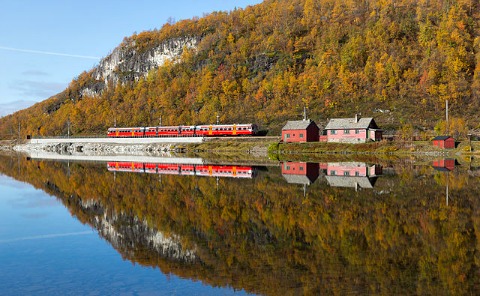 Bergen Line along Langavatnet
Bergen Line along LangavatnetPhoto by David Gubler, via Wikimedia Commons
- The voyage of discovery on the Bergen – Kirkenes – Trondheim route is my usual itinerary. It ends after breakfast on day 11. You will have enough time to fly back home, or take a ride by train on the Dovre Line to Oslo or its airport, and proceed from there.
- The voyage north, the northbound leg from Bergen to Kirkenes, ends in the morning on day 7. Flying back from Kirkenes is possible on the same day. However, you will miss Lofoten and Vesterålen islands during day 9, for many some of the absolute highlights of the tour.
- The shortest – and the cheapest – possibility is the voyage south from Kirkenes to Bergen. This usually requires flying to Kirkenes the day before your ship gets there, and spending a night waiting for it.
Getting to the start and back
Bergen
Bergen is the second-largest city in Norway with the population of 280,000 (420,000 in the metro area). It was founded in the 11th century and grew to become the capital of Norway 200 years later.
In the middle of the 14th century, German merchants established a Kontor, foreign trading post, of the Hanse at the Bryggen quayside in Bergen. This district is today on the UNESCO World Heritage List.
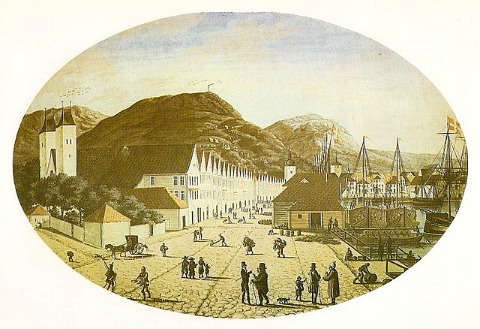 Bryggen in Bergen, watercolour by Joh. F. L. Dreier, 1817
Bryggen in Bergen, watercolour by Joh. F. L. Dreier, 1817Bergen's Flesland airport (IATA code BGO) is located 18 km (11 mi) from the city. The most convenient connections are on SAS from Copenhagen (5 daily) and on KLM from Amsterdam (4 daily). Another option is a daily service from London Heathrow on British Airways.
SAS also fly dozen times a day from Oslo. However, if you choose to connect there, you will have to collect your luggage and go with it through customs, drop it off for the connecting flight, and proceed through security again.
Something else to consider: Checked luggage on KLM flights in the economy class within Europe is free only when connecting from or to a trans-continental flight. SAS, on the other hand, let you check at least one piece of luggage for free in all categories but their cheapest (which they call Go Light).
Norway's low-cost carrier Norwegian serve several airports in Europe with irregular frequency, but their flights are usually only of interest for direct passengers. Still, they fly to Bergen from Berlin (Schönefeld), London (Gatwick), Paris (Orly), Rome (Fiumicino), Stockholm, as well as Copenhagen and Oslo.
Flybe connect Bergen and Glasgow with 2 weekly flights.
For North Americans, it is possible – and quite convenient – to fly with Icelandair via Keflavík.
Trondheim
Trondheim, with 190,000 inhabitants third-biggest community in Norway, was founded in 997 AD. It served as the Viking Age capital of Norway until 1217. Today, it publishes the oldest daily newspaper in the country (since 1776) and is its most important scientific and research centre, with 30,000 students.
If you decide to finish your voyage in Trondheim and fly home from here, KLM to Amsterdam (3 daily flights) and SAS to Copenhagen (twice daily) are again your best options. SAS also fly to Oslo all day long.
Trondheim airport in Værnes (IATA code TRD) is located 35 km (22 mi) away from the city. The bus to the airport stops at the Hurtigruten pier.
Kirkenes
Now this is really remote. Kirkenes is a small community with some 3,500 people living there. It got its town status in 1998. Its airport Høybuktmoen (IATA code KKN) is 10 km (6 mi) away. SAS serve the airport with 2 daily flights from and back to Oslo (one flight during weekends).
The way north
- Day 1: Departure
- The new Hurtigruten terminal is located at Nøstegaten 30. If you booked your flights with Hurtigruten, a bus transfer to the ship is included with the air package.
Otherwise, take one of the Flybussen from the airport to Festplassen, and walk from there just over 1 km/.7 mi. A ticket bought in advance costs 100 NOK (ca. 9.5 EUR/11.5 USD/9 GBP). Buses depart every 10 minutes during the day. You should be able to reach your destination in about 40 minutes.
Alternatively, consult Avinor service desk or the bus stop timetable for an occasional direct service to the terminal.
A taxi ride for up to four passengers costs around 400 NOK when flagged down at the rank.
Bergen is a beautiful city, if not for its weather. Its seaside location with mountains in the background results in 200 rainy days on average during the year. On the other hand, winters are rather mild for a place beyond 60°N, though summers rarely get warmer than 20°C (68°F).
Still, if you get a chance, stay for a while.
Your ship will depart at 10:30 pm from November through May and at 8 pm from June through October. Luggage check-in starts at 1 pm, while passengers can check-in from 3 pm, and boarding begins at 4 pm. Compulsory safety briefings are held before embarkation at quarter to / quarter past an hour. Cabins are available from 6 pm. - Day 2: Ålesund, Geiranger, or Hjørundfjorden
- The day sports the most varied itinerary of the whole journey, depending on season.
Explore the Art Nouveau town of Ålesund during the three-hour stay in winter and spring. The old settlement built of wood burnt down entirely in the night of January 23, 1904 (only one person died in the fire). Kaiser Wilhelm of Germany, a regular visitor to the region, organised help to build shelters and barracks. The new town was rebuilt in stone in the then-modern style.
The town is spread over several islands. The terminal is located within walking distance to some nice examples of early 20th-century architecture. It is also possible to climb Aksla, the hill overlooking the place.
In summer, the ship sails through Geirangerfjorden, one of the most dramatic along the entire Norwegian coast. The cliffs surrounding its course tower up to 800 m (2,600 ft) and feature numerous waterfalls. Many turns and curves open to magnificent views.
During the fall, enjoy the rarely visited Hjørundfjord. On my only visit in autumn (of 2005), the fjord wasn't yet "on the map", but I'd expect it being nothing but stunning.
Recommended excursions:- Geiranger with Trollstigen pass (June to August). Go on land by a tender boat in Geiranger and board a bus for an unforgettable ride over Trollstigen pass and 11 hairpin turns on the way down to Roms-dalsfjorden. Meet your ship in Molde after dinner ashore.
- Mountain hike in the Hjørundfjord (September and October)
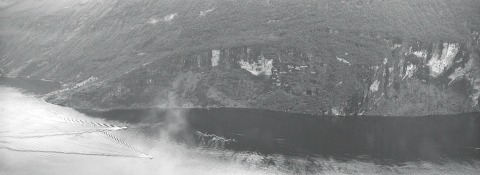 Vertigo • Above Geirangerfjorden
Vertigo • Above Geirangerfjorden - Day 3: Trondheim
- Pay a visit to the first capital of Norway. Your ship stays in port from 6 in the morning (from 8:30 am between September and March) until noon. The southbound Hurtigrute will dock along the same pier till 10 am and be open for visits. You can join an organised city sightseeing tour, but you'll have enough time to explore on your own. Printed city maps will be available at the reception on your ship. Consider, for example, the following walk:
Head from the ship to the Nidelva river, and follow it along Havnegata. Walk below the railway line and continue straight ahead to cross the river branch to your right. Pass the Clarion hotel on your right and turn left onto Olav Trygvasson gata, named after the city founder. Now cross the Nidelva and keep to the right until you reach Nedre Bakklandet. Turn onto it to the right.
You are now in the old town with many things to explore, or just to enjoy a coffee in Kafé Soil at 20d (open from 10 am Wednesday to Saturday). The nearby Nidelva promenade offers nice looks to the opposite shore.
Cross the Nidelva back over the Gamle Bybru, "old town bridge", and follow Bispegata to the nearby Nidaros cathedral, Nidarosdomen. The church was built between 1070 and 1300 over the burial site of Olav II. The King of Norway was killed in 1030 on a battlefield and canonised as Saint Olav to become the patron saint of the nation. A Lutheran church since the Reformation, it is the northernmost medieval cathedral in the world. The building is open for visits daily from 9 am. The entry costs 80 NOK.
From here, continue along Munkegata to Stiftsgården, the royal residence since 1800 in the largest wooden house in Northern Europe. In summer, guided tours are available on weekdays from 10 am every hour on the hour.
Continue on Munkegata until the crossing with Olav Trygvasson gate and turn right. Modern Art Gallery at no. 33 represents over 30 artists and opens daily except on Sundays at 10 am. From here, it is probably time to return to the ship for your well-earned lunch. Your ship will retrace back out of Trondheimsfjorden and on to the longest stage to Rørvik.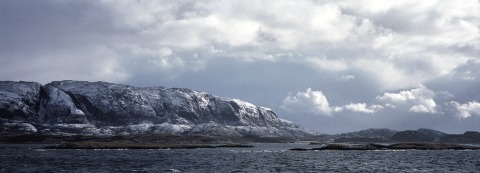 Fresh breeze • TrondheimsfjordenRecommended excursions:
Fresh breeze • TrondheimsfjordenRecommended excursions:
For those inclined, it is possible to participate in a guided kayaking tour on the Nidelva (summer only) or a cycling city tour (April to August). - Day 4: Crossing the Circle
- This is a very exciting day. It starts with crossing the Arctic Circle between Nesna and Ørnes. Usually, there is a competition to guess the exact time when the ship will pass this imaginary line at 66°33'N, and a short ceremony on deck.
From now on, you are officially in the Arctic! Enjoy the midnight sun in summer and northern lights in winter (though the latter are possible any time between September and March).
After a stay in Bodø, the capital of the Nordland region, your ship will cross the Westfjord to Lofoten Islands in the afternoon.
Recommended excursions:
You sure will be spoilt for choice!- In summer, your ship will stop at sea and let you transfer to a small tour boat which will bring you into the Nordfjord and to the observation point opposite the Svartisen Glacier. After visiting the information centre, you'll head to Bodø to rejoin with the ship.
- From April through October, board a RIB (rigid inflatable boat) for a sea safari to Saltstraumen. The world's most powerful tidal current featured in Jules Verne's 20,000 Leagues under the Sea, Edgar Allan Poe's A Descent into the Maelström, and in a story told by Captain Ahab in Moby Dick. Experience this natural phenomenon up close and personal!
- Upon landing in Stamsund, board a bus for a tour to the Highlights of Lofoten and on to Svolvær, where you'll meet your ship again.
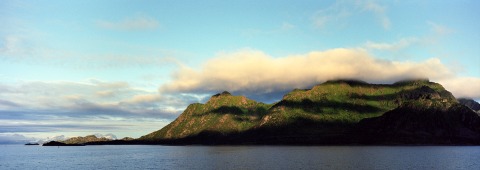 Bright side • Entering Raftsund, Lofoten
Bright side • Entering Raftsund, Lofoten - Day 5: Troms
- Spend the morning on deck while sailing north along the coasts of Senja, the second-largest Norwegian island off mainland, and Kvaløya, its fifth-largest.
In the early afternoon, your ship will dock at Tromsø, "the Arctic capital". Situated at 69°41'N, it is the northernmost city in the world with a population over 50,000. Excavations just outside the city limits revealed artifacts estimated at being 9,000 to 10,000 years old. In 19th century, Tromsø became the major centre of Arctic hunting. Today, the city is a university centre and home to the Norwegian Polar Institute.
Take a stroll through the centre with many old wooden houses, visit the Arctic Cathedral, Ishavskatedralen, across the long and high bridge over Tromsøysundet, spend some time in Ølhallen, the city's oldest pub (since 1928), or join one of the excursions.
Recommended excursions:- Dog sledding (November to April) on Kvaløya is an enjoyable, if quite expensive, option. The actual ride is about 6 km/4 mi long and takes 30-40 minutes.
- Silent whale exploring (November to February) aboard the Icelandic-flagged hybrid-driven schooner Ópal, is a new addition to the program and well worth trying, in my opinion.
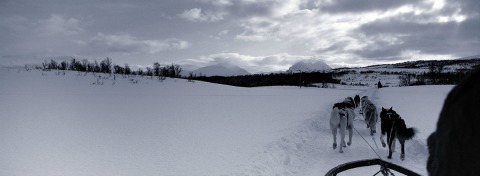 Sledding • Kvaløya, Troms
Sledding • Kvaløya, Troms - Day 6: North Cape
- A day on top of Europe! After a short stop in Havøysund around breakfast time, the ship sails along the coast of Magerøya to Honningsvåg, you may have guessed it, the northernmost city of Norway.
Though actually not half as populous as required to be called a city, the town was granted its status in 1996. A visit to the North Cape from here is a must, after which the ship will continue around the northern tip of the European mainland to the most remote settlements on your route.
In season, the stretches between Mehamn, Berlevåg and Båtsfjord are your best chances to see northern lights.
Recommended excursions:- The North Cape tour is available throughout the year and highly recommended. From there, be sure to look at the real North Cape, Knivskjellodden, a mile further north.
- From December to mid-May, a snowmobile trip in the Arctic is possible between Kjøllefjord and Mehamn. (Part of the route is covered by bus.)
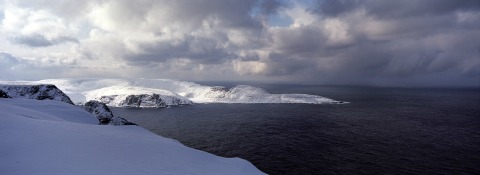 True North • Knivskjellodden looked at from North Cape
True North • Knivskjellodden looked at from North Cape - Day 7: End of the line
- During the night the ship sails around the Varanger Peninsula. If you manage to get up early, the town of Vadsø on its southern coast is possibly the least known port along the route. The stop of half an hour happens around 7 am, and ship bypasses it altogether on its way due south.
Kirkenes is reached at 9 am, after 1,460 nautical miles (2,700 km) in summer. The Russian border is only 10 km (6 mi) away, and you can visit it on some of the excursions, by bus, river boat, or ATV.
The ship remains docked rather far from the centre for over three hours. The place is a typical frontier town, with signs in both Norwegian and Russian and souvenirs from both sides of the border.
Some passengers will leave here, while others will join. In the early afternoon, the ship will set sail for its journey back south.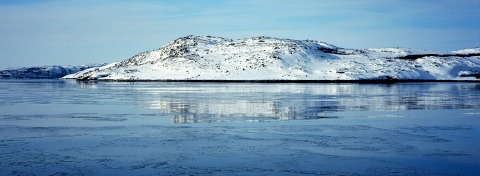 Cold waters • In Varangerfjorden towards Kirkenes
Cold waters • In Varangerfjorden towards Kirkenes
The return
- Day 7: Around Varanger
- The afternoon starts with crossing Varangerfjorden back north. In Vardø, Norway's easternmost settlement, you have an option to visit an old fortress built to protect Norwegian interests against Novgorod in this corner of the country. This is (of course) the northernmost star fort in the world.
The first fortification erected here dates from 1306. The modern structures were laid out in the 18th century.
The fortress didn't see any military action until World War II. Today it is manned by the Royal Norwegian Navy and serves mainly as a salute fortress. The only trees in Vardø stand on its premises.
The evening is again a great opportunity to hunt northern lights.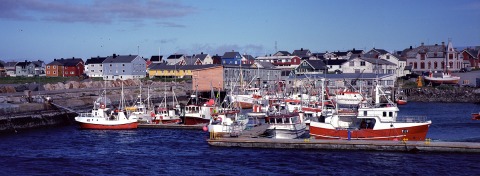 Harbour • Vardø
Harbour • Vardø - Day 8: Hammerfest
- In the wee morning hours, you can disembark in Honningsvåg and visit the North Cape before everybody else for breakfast (May through September). This is a magic – and somewhat surreal – experience having an otherwise overrun place for yourself.
The bus brings you afterwards back to Honningsvåg and through an underwater tunnel to the mainland, then continues along the Porsangerfjord to Hammerfest. This is a great ride and quite an adventure (that is, if you can restrain yourself from sleeping in your seat).
If you stay on board, the barren – and very dramatic – shores of Sørøya will accompany you en route to Hammerfest.
Hammerfest used to be the northernmost city before Honningsvåg was promoted to become the one. The community is busy with commercial fishery and serves as location for a large liquefied natural gas site.
American author Bill Bryson visited Hammerfest in the 1990s to see northern lights, and described it as "an agreeable enough town in a thank-you-God-for-not-making-me-live-here sort of way".
Out of Hammerfest, the ship sails south back into Troms, and visits the beautiful Lyngenfjord in spring. Tromsø is reached in time for the midnight concert in the Arctic Cathedral. If you enjoyed your breakfast at the North Cape, this would round off a very long day.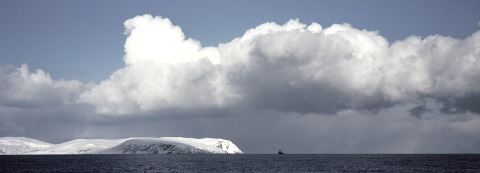 Offshore • Sørøya island in the Norwegian Sea
Offshore • Sørøya island in the Norwegian Sea - Day 9: Vesterålen and Lofoten
- For many this is arguably the most exciting day of all. Start after an early breakfast in Harstad with the quest for a taste of Vesterålen (all year). The excursion begins with a visit to the medieval church of Trondenes. By bus and ferry, you follow then all across Hinnøya, the largest island off the mainland of Norway. You will meet the ship again in Sortland, just in time to see it pass under the bridge connecting Hinnøya with Langøya, while your bus drives over it.
In Stokmarknes, be sure to visit the Hurtigruten museum with the complete ship, MS Finnmarken (in service from 1956-1999), on exhibition.
After that, go on deck to see the wall of Lofoten Islands rise over your ship as it approaches Raftsundet. In summer, the ship will make a detour into the short and narrow Trollfjord. Transfer there onto a tour boat for a fascinating sea eagle safari, and see your ship turn around in the narrow space between towering mountains.
If this wasn't enough, after reaching Svolvær you can join one of several excursions for the action-minded: a horse ride, a RIB safari, or a fishing trip.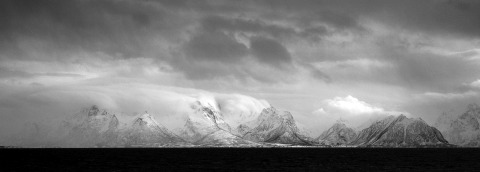 The wall • Approaching Lofoten
The wall • Approaching Lofoten - Day 10: Sagaland
- In the morning, the ship crosses back the Arctic Circle and continues south along the coast of Helgeland. Its waters are full with small islands, and the shores feature cliffs and mountains telling the stories about old times when trolls and giants populated the area. In the afternoon, the last of these formations, Torghatten, resembling a hat with a hole in it, rises above the water as if in the farewell salute. — This was always my last day on board.
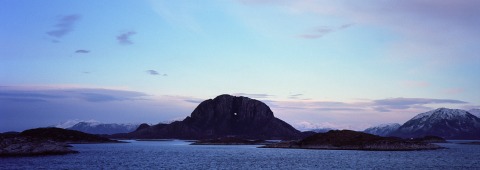 Old hat • Torghatten, south of Brønnøysund
Old hat • Torghatten, south of Brønnøysund - Day 11: Atlantic Road
- The highlight of the day should be the bus excursion on the Atlantic Road connecting several islands over eight bridges. The tour starts in Kristiansund in the late afternoon and finishes in Molde in the evening.
- Day 12: Bergen
- That's it, you made it! You probably will be asked to clear your cabin after breakfast. The last excursion is available for booking only on board. It's a small sightseeing tour of Bergen, in the end of which you will be dropped off at your hotel or at the railway station.
Have a safe journey home!
In search of a perfect gift?
Consider Northern Light, a luxury photo book with 48 original panoramic photographs from Norway, Svalbard and Canadian Arctic, seamlessly printed edge to edge over the fold!
Useless knowledge: On track
Norway's best known music export since Edvard Grieg, a-ha, was formed in 1982 by Morten Harket, vocals, Magne Furuholmen, keyboards, and Pål Waaktaar-Savoy, guitars.
- The group was named after an unreleased song. "It was a terrible song, but a great name."
- The band must have sold over 80 million records worldwide, and performed at over 600 concerts.
- Between 1985 and 2015, the trio published 10 studio and 3 live albums. Their first album, Hunting High and Low, was their most successful.
- The single Take on Me from this album was the 3rd version of the song. This recording and its accompanying video peaked at number 1 on the Billboard Hot 100 in the US and at number 2 on the UK Singles Chart.
- The video for Take on Me used the technique of rotoscoping to mix live band footage with pencil drawings created from the same. 3,000 frames were processed in this manner, which took 16 weeks to complete.
- The girl in the video is Bunty Bailey, Harket's girlfriend at the time.
- The clip for The Sun Always Shines on TV begins with telling the story from Take on Me to the end.
- At the 1986 MTV Video Music Awards, the group were nominated 11 times for both Take on Me and The Sun Always Shines on TV, and won 8 awards.
- The title song to the 15th James Bond film, The Living Daylights, written by Pål Waaktaar and performed by a-ha, was the first one created by authors not from the UK or the US.
- During the 2nd Gulf War in 1990, BBC restrained from playing the song Hunting High and Low, deemed "unsuitable".
- The band have earned two entries into the Guinness World Records book, for the largest paying audience at a concert (198,000 in the Maracanã at Rock in Rio in 1991), and for the longest live note held by a singer in a Top 40 hit song (20.2 seconds by Morten Harket performing Summer Moved On in 2000). Both records still hold.
- The footage from Rio is used in the video for Early Morning, directed by Lauren Savoy, Pål's wife.
- The video for Lifelines opens with a quote from a poem by King Olav V of Norway.
“When I look back
I see the landscapes
That I have walked through
But it is different.
All the great trees are gone.
It seems there are
Remnants of them
But it is the afterglow
Inside of you
Of all those you met
Who meant something in your life”
Olav Rex, August 1977
- In November 2012, the three group members were appointed Knights of the 1st Class of the Royal Norwegian Order of St. Olav.
Tags: #inplainlight #norway #hurtigruten #a-ha
Recommended links
- Hurtigruten Cruises: Norway
- I think the new website is extremely difficult to use when looking for information before actual booking. If you consider the latter, ask your travel agent – they will be able to help answer your questions.
- Vestland Classic
- The new owners of the former Hurtigruten ship Nordstjernen organised the journey I am writing this from (photos follow, fingers crossed).
- SAS Scandinavian Airlines
- The flag carrier of three Scandinavian kingdoms, Denmark, Norway, and Sweden, and the founding member of Star Alliance.
- KLM Royal Dutch Airlines
- The flag carrier of the Netherlands, and the oldest airline in the world still in service (since 1919).
- Flybussen: Airport Express Coach
- Book your bus ticket from the airport online, and save.
- a-ha YouTube channel
- Over 25 years performing together (over 30 with breaks), and planning another European acoustic tour in 2018.
- Portfolio by Marius Rustad
- In 2009, the now digital-only Silvershotz magazine published a feature about the Norwegian photographer and his medium-format series Close to Home. I am still very impressed.
Norway pictures
- Norway travel photography prints
- See a selection of my Norway pictures and order your favourite on a large framed print!
- Norway
- A travel diary of my third Hurtigruten cruise along the Norwegian coast, in March 2011.
- Midsummer
- Another Hurtigruten cruise, my first in summer, in the very cold June of 2013.
- Equinox
- Again with Hurtigruten, in the end of March 2014.
- Northern Light
- Just a few pictures from Norway (May 2015) with many more others from Iceland and Greenland.
- In Transit
- From Bergen in Norway to Hamburg in Germany, with Denmark along the way (April 2017).
- True North
- Around Spitsbergen, the far north of Norway, on a small ketch in July-August 2017.
Previous issue
- 04.17 – The retro issue
- This issue is about the past, the longing for it, and the ways to satisfy this longing.
Following issue
- 06.17 – The Photoshop basics issue
- Join me as I scan my images and edit them in Photoshop, and learn some funny facts about the application while at it.
Other destinations
- Iceland
- This is as wild and as civilised as it gets, in a place where both extremes are barely an hour drive apart. The island halfway between Europe and North America has it all, and in spades.
- Greenland
- The name of the planet's biggest island might be the first hoax known to humanity, but its unspoiled natural beauty is nothing but stunning.
- Antarctica
- You can live without visiting it, but after having seen it you'll be kicking yourself for waiting. Go now.
- Norway
- In a dedicated newsletter issue, follow me along the coast of the happiest country in the world, all the way around the North Cape to the Russian border—and back.
- Northern Ireland
- Embark on a journey to Game of Thrones filming locations in Northern Ireland, and find out more about both the show and the country.
Unattributed images on this page are sourced from public domain via Wikimedia Commons.
|
Tell me what you think!
Is it useful 👍? Awful 👎? Leave a message! Your comments help make this site better (and give me a kick—one way or another).
Popular articles
-
A kind of magic
If a digital picture has to be seen in the real world, printed on a real medium and displayed in a real showcase, its transition from RAW to real is better done in an old school image editor. Enter A…
-
A duck for a dog
If you got your own place on the Internet, helping your visitors find what they are looking for is a great way to engage them and keep them staying a bit longer. A custom site search can achieve just …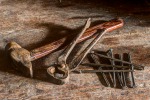
-
"Might as well have the best"
Aiming for better images? Think better lenses! This is your most important piece of gear, so you better get it sorted out. — Need some advice?
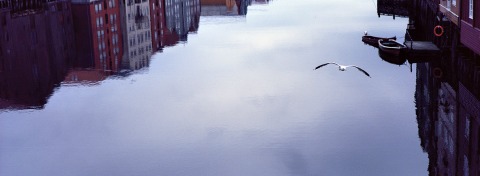
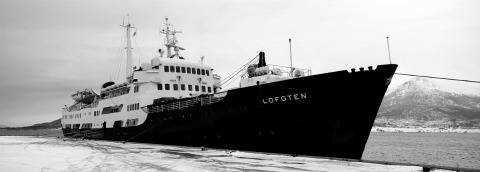
 Become a patron for
Become a patron for